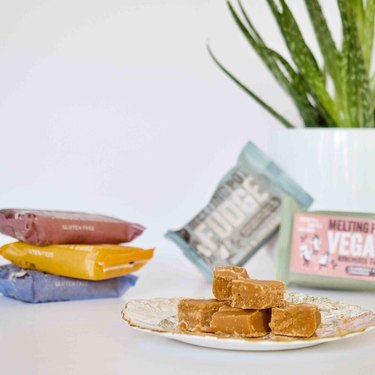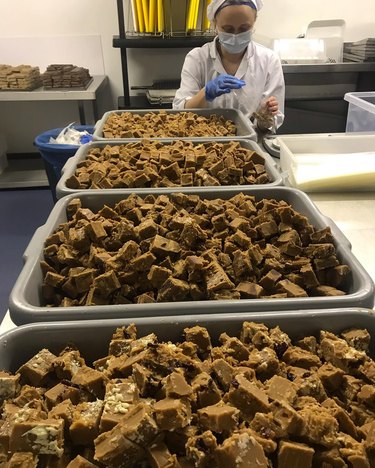
Three sisters who run a fudge factory in the heart of Belfast, Northern Ireland... We know, we know, it sounds like the plot of a Willy Wonka–esque movie. But it's the real-life story of Dorothy "Dot" Bittles and her older sisters, Cathy and Jenny, who since 2004 have run and operated Melting Pot Fudge. The company combines the rich, comforting goodness of traditional Irish fudge with one very important secret ingredient: family. "I just can't imagine how it would work if we weren't family," Dot says. "My sisters and I have worked together for 35 years now, so we've developed thick skins. You can disagree strongly and have a row one afternoon, and then the next morning it's all forgotten. I think because we work so closely together, it actually helps that we're family."
Video of the Day
The sisters, who once upon a time also operated a salad business together, shifted to fudge with a little inspiration from their sweets-loving father. "Our dad has a terrible sweet tooth, but Mum never allowed him many sweets," Dot explains with a laugh. "So he has always made his own fudge and toffee." When their father retired and began selling homemade confections at local shops, the sisters saw potential for a new family-owned business—and Melting Pot Fudge was born.
Video of the Day
Now the sisters are taking their family love of sweets to new heights, from their 3,500-square-foot facility in Belfast to markets across the globe (literally—you can find Melting Pot fudge in stores from New York to Germany and beyond). We chatted with Dot about family ties, vegan sweets and how unique flavors like garlic fudge (yes, garlic fudge!) set Melting Pot Fudge apart.
Your fudge recipe has literally been passed down through the generations. How did you streamline the process without any "formal" training?
DOT: My dad made fudge with his mum, and it sounds such a cliché, but it really was passed down to us. When we started out, we read tons of books about making fudge and wrote things down. It was an adjustment because when we were making it at home for ourselves, it didn't matter how one batch was a little too soft or hard because we were eating it straight away.

But when you're selling a product with a shelf life and someone's paying to buy a bar and eat it, you want it to be the same every time. Really, it's just been learning it. And it's very hard to teach someone, so my sisters and I are all very involved in production to this day. Although we have staff, we are still the boilers and the beaters—we're always guiding our staff. And luckily enough, we've had a few staff members for years. So it's knowledge grasped over time.
Not in Northern Ireland? No Problem
Ready to sink your teeth into some of Melting Pot's delicious fudge, but not planning to be in Belfast anytime soon? Never fear: Customers in the United States and beyond can order treats directly through the Melting Pot Fudge online shop. Check out an assortment of gift boxes, individual fudge squares and specialty items, then wait for your goodies to arrive!
Was working with food a dream for you?
DOT: It wasn't the original goal, no. My sisters and I all went to university for different things—one is trained as a social worker, and the other has a business degree. I trained as a teacher, but then I realized I only like children I'm related to! So yes, we had schooling in other fields. But when you're discussing career options, being self-employed and starting your own business never seems to be an option. It's never something that's talked about in schools or encouraged, but we really think that it should be.
Absolutely. There's so much freedom in being self-employed.
DOT: Yes, and especially as a mother, being self-employed lets you to fit your work around your children. Our business is also run by women, and we've tended to employ women, which I'm proud of. We've always sort of fit work around our lifestyle rather than the other way around, which has been lovely. So making fudge was never an original career choice, but it's been lovely.
Your father must be proud of what his sweet tooth inspired. Is he still involved with the business?
DOT: When we got our first premises, he was very much on board—he was still the fudge beater! We weren't making too much, but then as we grew and he got older, his role sort of decreased. Now that he's in his mid-80s, he's not as involved with production. On a boiling day, we'll make 3,600 bars of fudge, and that's all handmade in small batches. So it's too much for him physically, but he's still very much involved in other ways. He'll still pop down to the factory to see what's going on, hear about new customers and all that.
It sounds like you stay busy in the facility. Does it smell amazing with all those pots of fudge brewing?
DOT: Oh, it smells so good, yeah. It's just one room with all these small pots. Each pot mixes 60 bars and each bar is a 100 grams, so it's six kilos spread out across those hot pots. Fudge is a real science. Everything has to be temperature-controlled to the nth degree, because things like the weather can even affect how a batch turns out. Making fudge in America would be very different from making fudge in Ireland, for example, just because of the weather conditions.
How Is Fudge Made?
"Fudge is very labor-intensive," Dot explains. "It takes a full 24 hours from putting the pot on to wrapping the completed fudge."
To begin, Dot and other Melting Pot employees fill a pot with ingredients, place the pot on a heating ring and watch the ingredients dissolve. Next, the fudge is boiled to a specific temperature before coming off the ring for an hour. From there, it moves to cooling tables for another hour until its temperature drops just enough. The beating table is next. "There's actually no set temperature for the beating step," Dot says. "That's by eye—we can just tell when it's beaten enough based on color and texture."
Next, the fudge is moved to another table and placed into trays to be cooled on racks overnight. Before it's completely set, Melting Pot employees add grid marking to prepare the fudge to be broken into bars. The next day, the cooled product is removed from trays and split into bars. The last step is weighing and wrapping. "We actually used to hand-wrap each bar until about ten years ago!" Dot says.
You're often at local markets, but have you exported your fudge?
DOT: We have! We do a bit to Germany, and we've sent fudge to the Chelsea Market Baskets in New York. We sell a lot to specialty wholesalers throughout the U.K., and hamper companies (gift baskets) are the largest portion of our business. People can also find our fudge at some of the more touristy places, like the Giant's Causeway, because we work with a lot of National Trust Properties. Oh, and we have a line of fudges that carry the Royal Warrant, which means they're stocked by the royal family's grocers!
The fact that you make vegan fudge is a major perk for many customers. What inspired that choice?
DOT: My sister's daughter, my niece, had terrible health issues related to milk intolerance. Since fudge is such a big part of our family, we ended up developing a vegan version for her so she could still enjoy it. It grew from there. We do a lot of sales at local markets, and it's always really rewarding when you have a vegan customer who says, "Oh, I love fudge, but I haven't been able to eat it in so long." All of our fudge is gluten-free and made with natural ingredients too.
Let's talk flavors! Do you have a favorite?
DOT: Oh, everyone always asks when I'm working at the market! And the honest answer is it depends. My favorite flavor changes all the time, because I'll eat it far too much and be like, "Oh, I love the rum and raisin," and then it's like, "Oh, I'm done with rum and raisin. I've eaten far too much of that." And I'll switch to something else. The best-selling fudge is the traditional butter fudge, which is just a plain fudge.
We actually do a garlic fudge, which is not one I like! It's sold on the cheese counter, so you have your cheese and crackers with a bar of fudge on top. One thing I've noticed is that Americans always think of fudge as chocolate. American tourists tend to get the chocolate because that's what they think fudge is meant to be. But chocolate is just one flavor!
What's next for Melting Pot Fudge? Do you have any goals on the horizon?
DOT: To be honest, no! We're just happy where we're at, and that's such a great place to be for a business. I've just turned 50, and I'm the youngest by 8 years. I've gone to lots of trade fairs and things like that—I've been to America, Denmark, Dubai.... All through work with the fudge, which has been great. We keep on saying, "Will we be doing this in our 60s?" And then we go, "I don't know. Will we?" And then it's like, "Will we be doing it in our 70s?" It's like we can't imagine not doing it, but I don't know. So the goal is just to tick along, tick along nicely.



